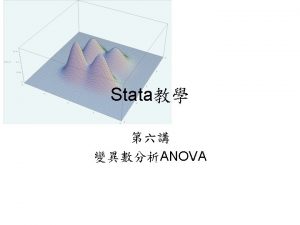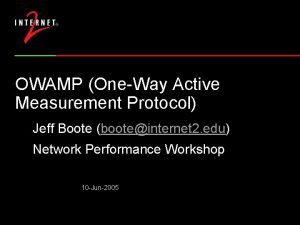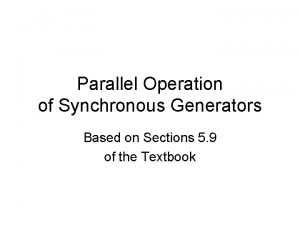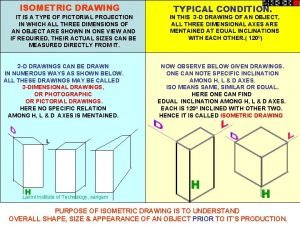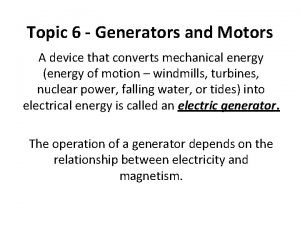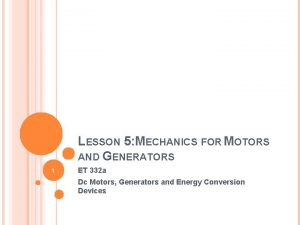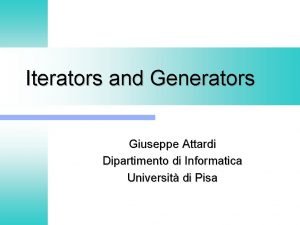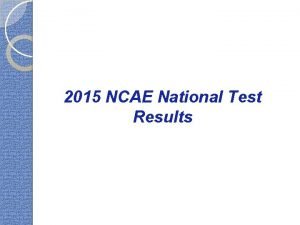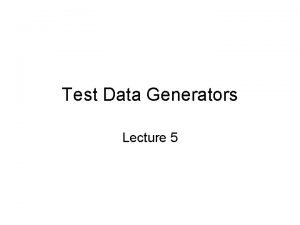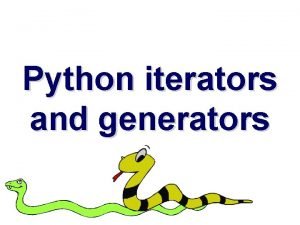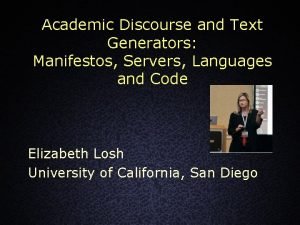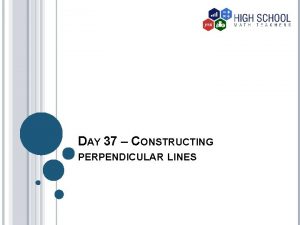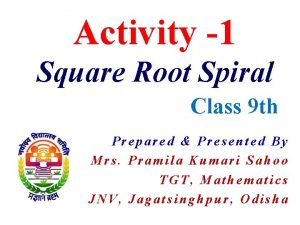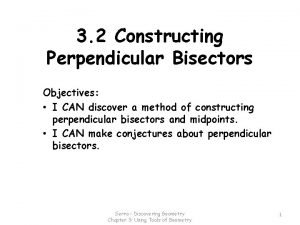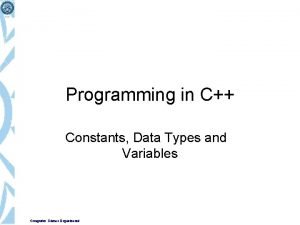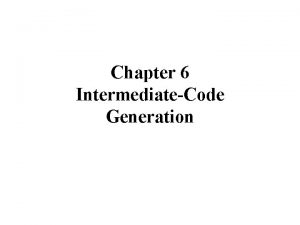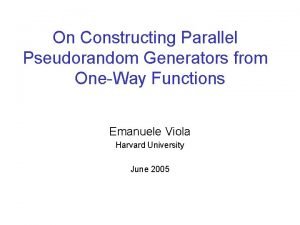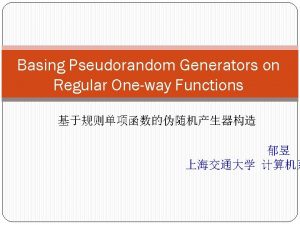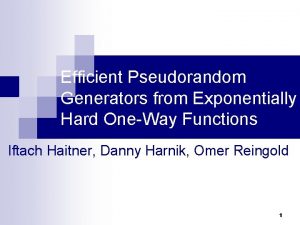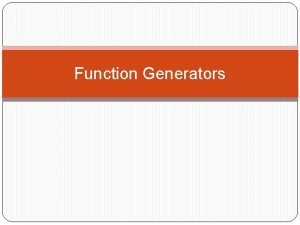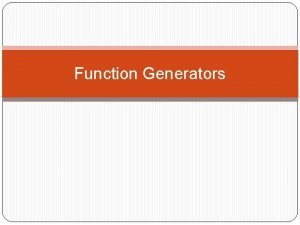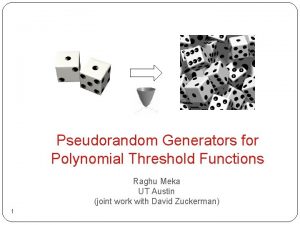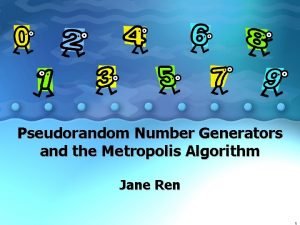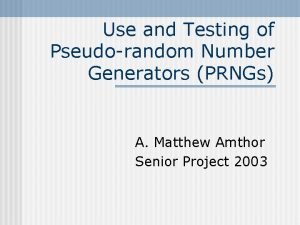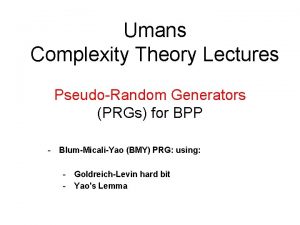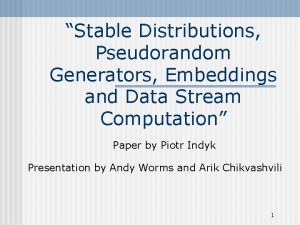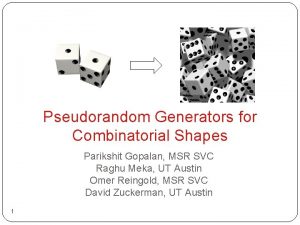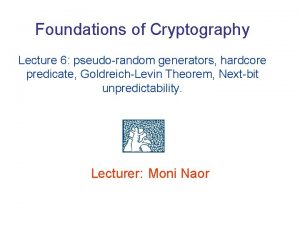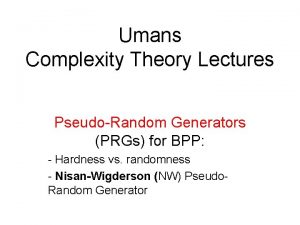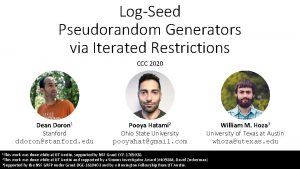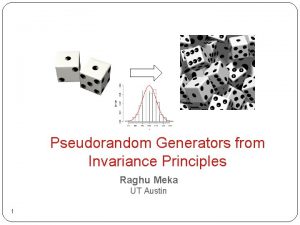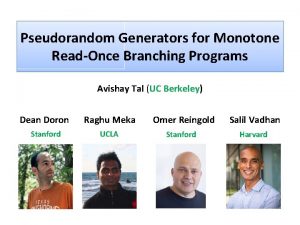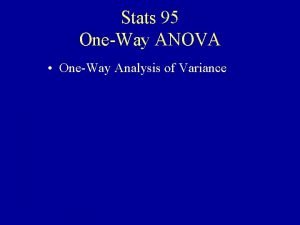On Constructing Parallel Pseudorandom Generators from OneWay Functions

![Pseudorandom Generator (PRG) [BM, Y] PRG • Poly(n)-time Computable • Stretch s(n) ¸ 1 Pseudorandom Generator (PRG) [BM, Y] PRG • Poly(n)-time Computable • Stretch s(n) ¸ 1](https://slidetodoc.com/presentation_image_h2/6e290d555e4447b2b6a52d39ed47f3aa/image-2.jpg)
![Background on PRG • PRG , One-Way Functions (OWF) [BM, Y, GL, …, HILL] Background on PRG • PRG , One-Way Functions (OWF) [BM, Y, GL, …, HILL]](https://slidetodoc.com/presentation_image_h2/6e290d555e4447b2b6a52d39ed47f3aa/image-3.jpg)


![Previous Results • [AIK] Log-depth OWF/PRG ) O(1)-depth PRG (!!!) However, any stretch ) Previous Results • [AIK] Log-depth OWF/PRG ) O(1)-depth PRG (!!!) However, any stretch )](https://slidetodoc.com/presentation_image_h2/6e290d555e4447b2b6a52d39ed47f3aa/image-6.jpg)



![Proof Sketch of Negative Result • Thm[this work]: Parallel black-box PRG constructions Gf : Proof Sketch of Negative Result • Thm[this work]: Parallel black-box PRG constructions Gf :](https://slidetodoc.com/presentation_image_h2/6e290d555e4447b2b6a52d39ed47f3aa/image-10.jpg)
![Def. of f and (1) break Gf • Restriction [FSS, H, …] maps bits Def. of f and (1) break Gf • Restriction [FSS, H, …] maps bits](https://slidetodoc.com/presentation_image_h2/6e290d555e4447b2b6a52d39ed47f3aa/image-11.jpg)


![Conclusion • Thm[this work]: Parallel black-box construction Gf : {0, 1}n ! {0, 1}n+s(n) Conclusion • Thm[this work]: Parallel black-box construction Gf : {0, 1}n ! {0, 1}n+s(n)](https://slidetodoc.com/presentation_image_h2/6e290d555e4447b2b6a52d39ed47f3aa/image-14.jpg)


![Pseudorandom Generator (PRG) [BM, Y, NW] PRG • Efficiently Computable • Big Stretch s(n) Pseudorandom Generator (PRG) [BM, Y, NW] PRG • Efficiently Computable • Big Stretch s(n)](https://slidetodoc.com/presentation_image_h2/6e290d555e4447b2b6a52d39ed47f3aa/image-17.jpg)


![Previous Results Æ • [N’ 91] PRG : {0, 1}n ! {0, 1}s(n) = Previous Results Æ • [N’ 91] PRG : {0, 1}n ! {0, 1}s(n) =](https://slidetodoc.com/presentation_image_h2/6e290d555e4447b2b6a52d39ed47f3aa/image-20.jpg)
![Our Results • Theorem[This Work]: {0, 1}n {0, 1}s(n) PRG : ! with s(n) Our Results • Theorem[This Work]: {0, 1}n {0, 1}s(n) PRG : ! with s(n)](https://slidetodoc.com/presentation_image_h2/6e290d555e4447b2b6a52d39ed47f3aa/image-21.jpg)
![The Pseudorandom Generator • [NW] style Input = 110101110110101110 f Output = 101010 …. The Pseudorandom Generator • [NW] style Input = 110101110110101110 f Output = 101010 ….](https://slidetodoc.com/presentation_image_h2/6e290d555e4447b2b6a52d39ed47f3aa/image-22.jpg)





![Tools • Random restrictions [FSS, H, …] : {x 1, x 2, …, xs} Tools • Random restrictions [FSS, H, …] : {x 1, x 2, …, xs}](https://slidetodoc.com/presentation_image_h2/6e290d555e4447b2b6a52d39ed47f3aa/image-28.jpg)
![Proof Sketch © • Thm[This Work]: f = GIP ○ PARITY = Æ Æ Proof Sketch © • Thm[This Work]: f = GIP ○ PARITY = Æ Æ](https://slidetodoc.com/presentation_image_h2/6e290d555e4447b2b6a52d39ed47f3aa/image-29.jpg)
![Conclusion • Theorem[This Work]: PRG : {0, 1}n ! {0, 1}s(n) with s(n) = Conclusion • Theorem[This Work]: PRG : {0, 1}n ! {0, 1}s(n) with s(n) =](https://slidetodoc.com/presentation_image_h2/6e290d555e4447b2b6a52d39ed47f3aa/image-30.jpg)
![C| low communication complexity • Lemma[this work]: C small AC 0 circuit w/ log C| low communication complexity • Lemma[this work]: C small AC 0 circuit w/ log](https://slidetodoc.com/presentation_image_h2/6e290d555e4447b2b6a52d39ed47f3aa/image-31.jpg)








![Conclusion • Theorem[This Work]: PRG : {0, 1}n ! {0, 1}s(n) with s(n) = Conclusion • Theorem[This Work]: PRG : {0, 1}n ! {0, 1}s(n) with s(n) =](https://slidetodoc.com/presentation_image_h2/6e290d555e4447b2b6a52d39ed47f3aa/image-40.jpg)
![Multiparty Communication Complexity • ``Number on the forehead’’ model [CFL] – – • • Multiparty Communication Complexity • ``Number on the forehead’’ model [CFL] – – • •](https://slidetodoc.com/presentation_image_h2/6e290d555e4447b2b6a52d39ed47f3aa/image-41.jpg)
![C| low communication complexity • Restriction [FSS, …] map variables to {0, 1, *} C| low communication complexity • Restriction [FSS, …] map variables to {0, 1, *}](https://slidetodoc.com/presentation_image_h2/6e290d555e4447b2b6a52d39ed47f3aa/image-42.jpg)

![Summary of Lemmas • Lemma[BNS]: Low communication complexity protocol P ) Prx[P(x) GIP(x)] ¸ Summary of Lemmas • Lemma[BNS]: Low communication complexity protocol P ) Prx[P(x) GIP(x)] ¸](https://slidetodoc.com/presentation_image_h2/6e290d555e4447b2b6a52d39ed47f3aa/image-44.jpg)

![Conclusion • Theorem[This Work]: PRG : {0, 1}n ! {0, 1}s(n) with s(n) = Conclusion • Theorem[This Work]: PRG : {0, 1}n ! {0, 1}s(n) with s(n) =](https://slidetodoc.com/presentation_image_h2/6e290d555e4447b2b6a52d39ed47f3aa/image-46.jpg)
![Proof Sketch • Tools: Random restrictions [FSS, H, …] – : {x 1, x Proof Sketch • Tools: Random restrictions [FSS, H, …] – : {x 1, x](https://slidetodoc.com/presentation_image_h2/6e290d555e4447b2b6a52d39ed47f3aa/image-47.jpg)
- Slides: 47

On Constructing Parallel Pseudorandom Generators from One-Way Functions Emanuele Viola Harvard University June 2005
![Pseudorandom Generator PRG BM Y PRG Polyntime Computable Stretch sn 1 Pseudorandom Generator (PRG) [BM, Y] PRG • Poly(n)-time Computable • Stretch s(n) ¸ 1](https://slidetodoc.com/presentation_image_h2/6e290d555e4447b2b6a52d39ed47f3aa/image-2.jpg)
Pseudorandom Generator (PRG) [BM, Y] PRG • Poly(n)-time Computable • Stretch s(n) ¸ 1 (e. g. , s(n) = 1, s(n) = n) • Fools efficient adversaries: 8 PPT A Pr. X, |X| = n+s(n)[A(X) = 1] ¼ Pr , | | = n [A(PRG( )) = 1]
![Background on PRG PRG OneWay Functions OWF BM Y GL HILL Background on PRG • PRG , One-Way Functions (OWF) [BM, Y, GL, …, HILL]](https://slidetodoc.com/presentation_image_h2/6e290d555e4447b2b6a52d39ed47f3aa/image-3.jpg)
Background on PRG • PRG , One-Way Functions (OWF) [BM, Y, GL, …, HILL] (f OWF if easy to compute but hard to invert, i. e. 8 PPT M, almost never M(f(X)) 2 f(X)-1) • Applications of PRG: cryptography, derandomization need stretch s(n) = poly(n) • Stretch s(n) only makes sense relative to n 2 n {0, 1} – E. g. G : ! )G: – Two main cases s(n) = 1, or s(n) = n {0, 1}n+s(n) ! 2 + n¢s(n) n {0, 1}

PRG Constructions • We study complexity of constructing PRG with big stretch from OWF f • Def. : black-box PRG constructions Gf : for every (comput. -unbounded) function f, adversary A A breaks Gf ) 9 PPT M : Mf, A inverts f • Most constructions are black-box [BM, Y, …, HILL] Many negat. results for black-box model [IR, …, GT, RTV] – Cannot make sense of negat. result in non-black-box model

Standard Constructions w/ big stretch • STEP 1: OWF f ) Gf : {0, 1}n ! {0, 1}n+1 n – Think e. g. f : {0, 1} ! {0, 1} Gf n • STEP 2: Gf ) PRG with stretch s(n) = poly(n) [GM] Input Gf Gf Gf … . . . . Output. . • Stretch s ) s adaptive queries to f ) circuit depth ¸ s • Question [this work]: stretch s vs. adaptivity & depth? E. g. , can have s = n, circuit depth O(log n)?
![Previous Results AIK Logdepth OWFPRG O1depth PRG However any stretch Previous Results • [AIK] Log-depth OWF/PRG ) O(1)-depth PRG (!!!) However, any stretch )](https://slidetodoc.com/presentation_image_h2/6e290d555e4447b2b6a52d39ed47f3aa/image-6.jpg)
Previous Results • [AIK] Log-depth OWF/PRG ) O(1)-depth PRG (!!!) However, any stretch ) stretch s = 1 • [GT] s vs. number q of queries to OWF (Thm: q ¸ s) [This work] s vs. adaptivity & circuit depth • […, IN, NR] O(1)-depth PRG from specific assumptions [This work] general assumptions • Context: [V] studies complexity of NW-type PRG

Outline • Our model • Our results • Proof sketch of main negative result • Other: new negative result on worst-case vs. average-case connections in NP, PH

Our Model of PRG construction • Parallel PRG Gf : {0, 1}n ! {0, 1}n+s(n) from OWF f Input , | | = n Nonadaptive Queries to f Constant Depth Circuit (AC 0) q 1 q 2 q 3 q 4 f f Æ Æ Æ Æ Ç Ç Ç Æ Æ Æ Æ Output, n+s(n) bits

Our Results on PRG Constructions • Parallel construction Gf : {0, 1}n ! {0, 1}n+s(n) n n From one-way function f ( e. g. f : {0, 1} ! {0, 1} ) f arbitrary f one-to-one f permutation Neg. s(n) · o(n) ? Pos. ? s(n) ¸ 1
![Proof Sketch of Negative Result Thmthis work Parallel blackbox PRG constructions Gf Proof Sketch of Negative Result • Thm[this work]: Parallel black-box PRG constructions Gf :](https://slidetodoc.com/presentation_image_h2/6e290d555e4447b2b6a52d39ed47f3aa/image-10.jpg)
Proof Sketch of Negative Result • Thm[this work]: Parallel black-box PRG constructions Gf : {0, 1}n ! {0, 1}n+s(n) satisfy s(n) · o(n) • Proof: Exhibit comput. -unbounded f, A such that: (1) A breaks Gf when s(n) = (n) (2) f one-way, i. e. hard to invert. We show distribution on f s. t. (1) & (2) hold w. h. p.
![Def of f and 1 break Gf Restriction FSS H maps bits Def. of f and (1) break Gf • Restriction [FSS, H, …] maps bits](https://slidetodoc.com/presentation_image_h2/6e290d555e4447b2b6a52d39ed47f3aa/image-11.jpg)
Def. of f and (1) break Gf • Restriction [FSS, H, …] maps bits to {0, 1, *} • Def. distribution on f apply to truth-table of f f(0) f(111) 01** 1*0* 1**0 0101 1100 1110 – known to adversary A replace * with random bits (1) A breaks Gf : 0 f 8 , G ( ) is AC function of truth-table of f ) makes Gf( ) biased ) A breaks Gf( ). – If s(n) = (n) can union bound over all .

(2) f one-way • Problem: f not one-way : leaks info about x E. g. f = 01** 1*0* 1**0 First bit f(x) = 0 ) x • Solution: Force many x’s to share same restriction Compose f with hash function f(0) f(10) f(111) hash 01** 1*0* 1**0 • Many preimages ) f one-way Low collision prob. ) A still breaks Gf Q. E. D.

Our Result on Average Case Complexity • Question: given f 2 NP worst-case hard (f 2 P/poly), can build f 0 2 NP average-case hard? I. e. 8 small circuit A : Prx[A(x) f 0(x)] ¸ 1/3 • Thm[V]: no black-box construction of f 0 using both function f and adversary A as black-box • Thm[BT]: no construction using A as black-box – Also uses A ``non-adaptively’’ • Thm[this work]: no construction using f as black-box – Proof uses pseudorandom restrictions
![Conclusion Thmthis work Parallel blackbox construction Gf 0 1n 0 1nsn Conclusion • Thm[this work]: Parallel black-box construction Gf : {0, 1}n ! {0, 1}n+s(n)](https://slidetodoc.com/presentation_image_h2/6e290d555e4447b2b6a52d39ed47f3aa/image-14.jpg)
Conclusion • Thm[this work]: Parallel black-box construction Gf : {0, 1}n ! {0, 1}n+s(n) satisfy f arbitrary f one-to-one f permutation Neg. s(n) · o(n) ? Pos. ? s(n) ¸ 1 • Average-case complexity Thm[this work]: given f 2 NP worst-case hard no construction of average-case hard f 0 2 NP using f as black-box


Pseudorandom Bits for Constant-Depth Circuits with Few Arbitrary Symmetric Gates Emanuele Viola Harvard University April 2005
![Pseudorandom Generator PRG BM Y NW PRG Efficiently Computable Big Stretch sn Pseudorandom Generator (PRG) [BM, Y, NW] PRG • Efficiently Computable • Big Stretch s(n)](https://slidetodoc.com/presentation_image_h2/6e290d555e4447b2b6a52d39ed47f3aa/image-17.jpg)
Pseudorandom Generator (PRG) [BM, Y, NW] PRG • Efficiently Computable • Big Stretch s(n) À n ( e. g. s(n) = n (1) ) • Fools small circuits: 8 small C Pr. X, |X| = s(n)[C(X) = 1] ¼ Pr , | | = n [C(PRG( )) = 1]

Do PRG Exist? • PRG ) derandomization: BP ¢ P ( EXP [Y, NW, …] • PRG , circuit lower bounds: EXP P/poly [NW, BFNW, STV, SU, …] • Open Problem: PRG exist? • This Work: study restricted PRG Only fool constant-depth circuits We know lower bounds for constant-depth circuits

PRG that fools constant-depth circuits • Constant-depth circuit = Depth x 1 : x 1 x 2. . : xs • PRG that fools constant-depth circuit PRG As before, but only fools small constant-depth circuit C Pr. X, |X| = s(n)[C(X) = 1] ¼ Pr , | | = n [C(PRG( )) = 1]
![Previous Results Æ N 91 PRG 0 1n 0 1sn Previous Results Æ • [N’ 91] PRG : {0, 1}n ! {0, 1}s(n) =](https://slidetodoc.com/presentation_image_h2/6e290d555e4447b2b6a52d39ed47f3aa/image-20.jpg)
Previous Results Æ • [N’ 91] PRG : {0, 1}n ! {0, 1}s(n) = n 2 , fools AC 0 Ç Ç Ç = Æ Æ Æ Æ x 1 : x 1 x 2. . . : xs • Applications: BP ¢ AC 0 ( EXP, more in [NW, HVV, V] • [LVW’ 93] PRG : {0, 1}n ! {0, 1}s(n) SYM s(n) = n log n, fools SYM ○ AND = Æ Æ Æ SYM = arbitrary symmetric gate x 1 : x 1 x 2. . : xs E. g. , SYM = PARITY, MAJORITY
![Our Results TheoremThis Work 0 1n 0 1sn PRG with sn Our Results • Theorem[This Work]: {0, 1}n {0, 1}s(n) PRG : ! with s(n)](https://slidetodoc.com/presentation_image_h2/6e290d555e4447b2b6a52d39ed47f3aa/image-21.jpg)
Our Results • Theorem[This Work]: {0, 1}n {0, 1}s(n) PRG : ! with s(n) = n log n fools AC 0 with log 2 n SYM = SYM Ç Ç SYM Æ Æ Æ Æ x 1 : x 1 x 2. . : xs • Improves on [LVW 93] Fools richer class than [N 91] but worse stretch • BP ¢ (AC 0 with few SYM) ( EXP Currently richest BP ¢ class one can derandomize
![The Pseudorandom Generator NW style Input 110101110110101110 f Output 101010 The Pseudorandom Generator • [NW] style Input = 110101110110101110 f Output = 101010 ….](https://slidetodoc.com/presentation_image_h2/6e290d555e4447b2b6a52d39ed47f3aa/image-22.jpg)
The Pseudorandom Generator • [NW] style Input = 110101110110101110 f Output = 101010 …. . . . 1 ………. . . 1010100 © f= [RW] Æ Æ © © x 1. . . xn © = PARITY

Outline • Why previous results/techniques do not suffice • For PRG need new average-case lower bound for AC 0 with few SYM • Proof sketch of average-case lower bound

Known Lower Bounds SYM • Recall AC 0 with log 2 n SYM = Ç Ç SYM Æ Æ Æ Æ x 1 : x 1 x 2. . : xs • [H, BNS, HG, RW, HM, CH]: f 2 P that requires AC 0 circuits with log 2 n SYM of size n log n • Often, lower bound ) PRG. But NOT this time!

Standard Approach To construct PRG that fools C (e. g. AC 0 with few SYM) h hard for C f hard on average for C [BFNW, STV, SU, …] PRG that fools C [NW] • Def. f : {0, 1}n ! {0, 1} average-case hard for C if 8 small C 2 C Prx[C(x) f(x)] ¸ ½ - n- (1)

Standard Approach Fails To construct PRG that fools C (e. g. AC 0 with few SYM) h hard for C f hard on average for C PRG that fools C Proving correctness 9 C 2 C C= h 9 C 2 C comp. f on average 9 C 2 C breaks PRG Problem: requires C ¶ TC 0. Is TC 0 ¶ NEXP? [RR] Conjecture [V]: Black-box construction ) C ¶ TC 0

Our vs. Previous Lower Bounds C = AC 0 with few SYM h hard for C f hard on average for C PRG that fools C [H, BNS, HG, RW, HM, CH] not average-case hard Theorem[This Work]: There is f 2 P s. t. 8 AC 0 circuit C of size n log n with log 2 n SYM Prx[C(x) f(x)] ¸ ½ - n- log n
![Tools Random restrictions FSS H x 1 x 2 xs Tools • Random restrictions [FSS, H, …] : {x 1, x 2, …, xs}](https://slidetodoc.com/presentation_image_h2/6e290d555e4447b2b6a52d39ed47f3aa/image-28.jpg)
Tools • Random restrictions [FSS, H, …] : {x 1, x 2, …, xs} ! {0, 1, *} C| subcircuit on *’s • Multiparty communication complexity [CFL] © Thm[BNS]: Gen. Inner Product (GIP) = Æ Æ has high x 1. . . . xn communication complexity
![Proof Sketch ThmThis Work f GIP PARITY Æ Æ Proof Sketch © • Thm[This Work]: f = GIP ○ PARITY = Æ Æ](https://slidetodoc.com/presentation_image_h2/6e290d555e4447b2b6a52d39ed47f3aa/image-29.jpg)
Proof Sketch © • Thm[This Work]: f = GIP ○ PARITY = Æ Æ is average-case hard for © © small AC 0 circuits with few SYM x 1. . . . xn • Proof sketch: C small AC 0 circuit with few SYM. W. h. p. over random restriction : E 1: GIP ○ PARITY| ¼ GIP ) high comm. complexity E 1 ( each bottom PARITY has * E 2: C| computable with low comm. complexity E 1 and E 2 ) C| (x) GIP(x) Q. E. D.
![Conclusion TheoremThis Work PRG 0 1n 0 1sn with sn Conclusion • Theorem[This Work]: PRG : {0, 1}n ! {0, 1}s(n) with s(n) =](https://slidetodoc.com/presentation_image_h2/6e290d555e4447b2b6a52d39ed47f3aa/image-30.jpg)
Conclusion • Theorem[This Work]: PRG : {0, 1}n ! {0, 1}s(n) with s(n) = n log n fools AC 0 with log 2 n SYM • Improves [LVW 93], fools richer class than [N 91] Currently richest BP ¢ class one can derandomize • Obtained from average-case hardness result Conj. : PRG from worst-case hardness ) C ¶ TC 0 • Open problems: (log 2 n) SYM? EXP average-case hard for GF(2) poly of deg. log n ?
![C low communication complexity Lemmathis work C small AC 0 circuit w log C| low communication complexity • Lemma[this work]: C small AC 0 circuit w/ log](https://slidetodoc.com/presentation_image_h2/6e290d555e4447b2b6a52d39ed47f3aa/image-31.jpg)
C| low communication complexity • Lemma[this work]: C small AC 0 circuit w/ log 2 n SYM W. h. p. over 2 Rp , C| low comm. complexity • Lemma[HG+HM]: Above holds for 1 SYM

More SYM gates • Lemma: C small AC 0 circuit with log 2 n SYM W. h. p. over 2 Rp , C| low comm. complexity • Proof: SYM 3 Ç Ç SYM 2 Æ Æ SYM 1 Æ Æ x 1 : x 1 x 2. . . : xs Consider following protocol

More SYM gates • Lemma: C small AC 0 circuit with log 2 n SYM W. h. p. over 2 Rp , C| low comm. complexity • Proof: SYM 3 Ç Ç SYM 2 Æ Æ SYM 1 Æ Æ x 1 : x 1 x 2. . . : xs Previous lemma ) low communication complexity

More SYM gates • Lemma: C small AC 0 circuit with log 2 n SYM W. h. p. over 2 Rp , C| low comm. complexity • Proof: SYM 3 Ç Ç SYM 2 Æ Æ 1 Æ Æ x 1 : x 1 x 2. . . : xs Parties compute value of SYM gate

More SYM gates • Lemma: C small AC 0 circuit with log 2 n SYM W. h. p. over 2 Rp , C| low comm. complexity • Proof: SYM 3 Ç Ç SYM 2 Æ Æ 1 Æ Æ x 1 : x 1 x 2. . . : xs Previous lemma ) low communication complexity

More SYM gates • Lemma: C small AC 0 circuit with log 2 n SYM W. h. p. over 2 Rp , C| low comm. complexity • Proof: SYM 3 Ç Ç Æ Æ 1 0 Æ Æ x 1 : x 1 x 2. . . : xs Parties compute value of SYM gate

More SYM gates • Lemma: C small AC 0 circuit with log 2 n SYM W. h. p. over 2 Rp , C| low comm. complexity • Proof: SYM 3 Ç Ç Æ Æ 1 0 Æ Æ x 1 : x 1 x 2. . . : xs Previous lemma ) low communication complexity

More SYM gates • Lemma: C small AC 0 circuit with log 2 n SYM W. h. p. over 2 Rp , C| low comm. complexity • Proof: 1 Ç Ç Æ Æ 1 0 Æ Æ x 1 : x 1 x 2. . . : xs Parties compute value of SYM gate

More SYM gates • Lemma: C small AC 0 circuit with log 2 n SYM W. h. p. over 2 Rp , C| low comm. complexity • Proof: Total communication = communication for 1 SYM X number of SYM Q. E. D. • Union bound over 2#SYM circuits limits # SYM. Open Problem: Better analysis?
![Conclusion TheoremThis Work PRG 0 1n 0 1sn with sn Conclusion • Theorem[This Work]: PRG : {0, 1}n ! {0, 1}s(n) with s(n) =](https://slidetodoc.com/presentation_image_h2/6e290d555e4447b2b6a52d39ed47f3aa/image-40.jpg)
Conclusion • Theorem[This Work]: PRG : {0, 1}n ! {0, 1}s(n) with s(n) = n log n fools AC 0 with log 2 n SYM • Improves [LVW 93], fools richer class than [N 91] Currently richest BP ¢ class one can derandomize • Obtained from average-case hardness result Conj. : PRG from worst-case hardness ) C ¶ TC 0 • Open problems: (log 2 n) SYM? EXP average-case hard for GF(2) poly of deg. log n ?
![Multiparty Communication Complexity Number on the forehead model CFL Multiparty Communication Complexity • ``Number on the forehead’’ model [CFL] – – • •](https://slidetodoc.com/presentation_image_h2/6e290d555e4447b2b6a52d39ed47f3aa/image-41.jpg)
Multiparty Communication Complexity • ``Number on the forehead’’ model [CFL] – – • • k-parties want to compute f(x) x partitioned in k blocks ! x 1 i-th party knows all x but xi Communication = broadcast x 2 xk Generalized Inner Product. GIP(x) = Æ © n k Æ k x 1. . xnk Lemma[BNS]: Low communication complexity protocol P ) Prx[P(x) GIP(x)] ¸ ½ - n- log n – Discrepancy, [CT, R]
![C low communication complexity Restriction FSS map variables to 0 1 C| low communication complexity • Restriction [FSS, …] map variables to {0, 1, *}](https://slidetodoc.com/presentation_image_h2/6e290d555e4447b2b6a52d39ed47f3aa/image-42.jpg)
C| low communication complexity • Restriction [FSS, …] map variables to {0, 1, *} – Rp = uniform distribution, Pr[ (xi) = *] = p – C| subcircuit. New input bits = * • Lemma: C small AC 0 circuit with log 2 n SYM W. h. p. over 2 Rp , C| low comm. complexity • First prove 1 SYM, then log 2 n SYM

1 SYM gate • Lemma: C small AC 0 circuit with 1 SYM W. h. p. over 2 Rp , C| low comm. complexity • Proof: [H] SYM Ç Ç Ç Æ Æ Æ Æ = Æ Æ Æ k-1 x 2 k-1 xk [HG] SYM ○ ANDk-1 low comm. complexity – 8 AND 9 party that can compute it (fan-in < k = # blocks) – Parties broadcast # AND = 1 – Communication = k ¢ log(size of circuit) Q. E. D.
![Summary of Lemmas LemmaBNS Low communication complexity protocol P PrxPx GIPx Summary of Lemmas • Lemma[BNS]: Low communication complexity protocol P ) Prx[P(x) GIP(x)] ¸](https://slidetodoc.com/presentation_image_h2/6e290d555e4447b2b6a52d39ed47f3aa/image-44.jpg)
Summary of Lemmas • Lemma[BNS]: Low communication complexity protocol P ) Prx[P(x) GIP(x)] ¸ ½ - n- log n • Lemma: C small AC 0 circuit with log 2 n SYM W. h. p. over 2 Rp , C| low comm. complexity • Want Theorem: There is f 2 P s. t. 8 AC 0 circuit C of size n log n with log 2 n SYM gates Prx[C(x) f(x)] ¸ ½ - n- log n

© Proof: f = GIP ○ PARITY = Æ Æ © © x 1. . . . xn C small AC 0 circuit with log 2 n SYM Random Input x = random + random y for the * • E 1: f | ¼ GIP ) high comm. complexity – E 1 ( each bottom PARITY has * • E 2: C| low comm. complexity Prx[C(x) f (x)] ¸ Pr , y[C| (y) f| (y) | E 1, E 2] Pr[E 1, E 2] = Pry[P(y) GIP(y)] (1 - n- log n) ¸ ( ½ - n- log n)
![Conclusion TheoremThis Work PRG 0 1n 0 1sn with sn Conclusion • Theorem[This Work]: PRG : {0, 1}n ! {0, 1}s(n) with s(n) =](https://slidetodoc.com/presentation_image_h2/6e290d555e4447b2b6a52d39ed47f3aa/image-46.jpg)
Conclusion • Theorem[This Work]: PRG : {0, 1}n ! {0, 1}s(n) with s(n) = n log n fools AC 0 with log 2 n SYM • Improves [LVW 93], fools richer class than [N 91] Currently richest BP ¢ class one can derandomize • Obtained from average-case hard function Conj. : PRG from worst-case hardness ) EXP TC 0 • Open problems: (log 2 n) SYM? EXP average-case hard for GF(2) poly of deg. log n ?
![Proof Sketch Tools Random restrictions FSS H x 1 x Proof Sketch • Tools: Random restrictions [FSS, H, …] – : {x 1, x](https://slidetodoc.com/presentation_image_h2/6e290d555e4447b2b6a52d39ed47f3aa/image-47.jpg)
Proof Sketch • Tools: Random restrictions [FSS, H, …] – : {x 1, x 2, …, xs} ! {0, 1, *} , C| subcircuit on *’s Communication complexity bound for GIP [BNS] • Theorem[This Work]: GIP ○ PARITY is average-case hard for small AC 0 circuits with few SYM • Proof sketch: C small AC 0 circuit with few SYM. W. h. p. over random restriction : E 1: GIP ○ PARITY| ¼ GIP ) high comm. complexity E 2: C| computable with low comm. complexity E 1 and E 2 ) C| (x) GIP(x) Q. E. D.
 Stata oneway
Stata oneway Owamp
Owamp Haval algorithm
Haval algorithm Parallel operation of synchronous generator
Parallel operation of synchronous generator Constructing parallel lines
Constructing parallel lines Types of pictorial projection
Types of pictorial projection How to construct a parallel line through a point
How to construct a parallel line through a point Topic 6 - generators and motors worksheet answers
Topic 6 - generators and motors worksheet answers New england power generators association
New england power generators association Units of torque
Units of torque In generators the welding current is produced on the ____.
In generators the welding current is produced on the ____. Abb motors and generators
Abb motors and generators Trane whole house generator
Trane whole house generator [email protected]
[email protected] Titanic adjectives
Titanic adjectives Empower custom field calculation
Empower custom field calculation Gentrack generators
Gentrack generators Difference between generator and manifesting generator
Difference between generator and manifesting generator Nfpa 2010 aerosol extinguishing technology
Nfpa 2010 aerosol extinguishing technology Find generators
Find generators X ray circuit diagram
X ray circuit diagram Wind generators
Wind generators Ncae test
Ncae test Test data generators
Test data generators Python iterators and generators
Python iterators and generators Text generators
Text generators Resultant of two unlike parallel forces
Resultant of two unlike parallel forces Outer terminus fingerprint
Outer terminus fingerprint Parallel and non parallel structure
Parallel and non parallel structure What is parallel structure
What is parallel structure Parallel and non parallel structure
Parallel and non parallel structure Serial in serial out shift register truth table
Serial in serial out shift register truth table Parallel structure english definition
Parallel structure english definition Materials and tools needed
Materials and tools needed What are the rules to construct a variable
What are the rules to construct a variable If ywz yxw what is true about xwz xwz is an obtuse angle
If ywz yxw what is true about xwz xwz is an obtuse angle Forming equations worksheet
Forming equations worksheet Construct perpendicular lines
Construct perpendicular lines Constructing triangles worksheet
Constructing triangles worksheet Constructing a pay structure
Constructing a pay structure Architecture is art and science
Architecture is art and science To construct a square root spiral activity class 9
To construct a square root spiral activity class 9 Constructing a perpendicular bisector
Constructing a perpendicular bisector Constant int
Constant int How to construct a regular hexagon inscribed in a circle
How to construct a regular hexagon inscribed in a circle Triangle construction worksheet
Triangle construction worksheet Value number method for constructing dag
Value number method for constructing dag Measuring and constructing angles worksheet
Measuring and constructing angles worksheet
